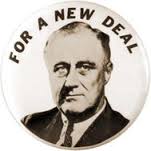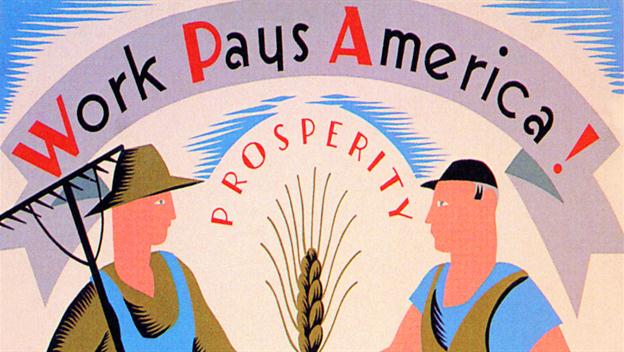How did the New Deal help the United States during the Great Depression?
1 Answer
By providing financial support and job opportunities for those affected by the depression.
Explanation:
The New Deal, implemented by Franklin Delano Roosevelt, was a series of government programmes aiming to restore economic stability in the US. The programmes aim was to help citizens suffering from the wall street crash and depression find new jobs, earn money and get back on track but they also helped returning WW1 soldiers, the elderly, widows and other vulnerable groups with financial issues and stabilized the price of food.
The Great depression was a period of time in which unemployment was high and economy was low. After the banks crashed (went bankrupt), people lost their life savings leading to the huge decrease in trade and therefore, jobs.

When Roosevelt was elected in 1932, the previous president (Herbert Hoover) had done little to help the situation. However, Roosevelt's New Deal was significantly more successful.
The programme is often split into what's known as the 3 R's:
Relief - This involved providing welfare payments to those who were desperate and unemployed. This let them buy food and shelter.
Recovery - The aim of recovery was to help fix the economy and get America functioning again. These programmes worked on getting Americans back to work and getting the banks running again. Key programmes included the WPA, PWA and CCC.
Reform The name given to attempts to prevent further recessions, and build a more stable and secure economy to safeguard the future.

Here are some of the programmes that were introduced:
EBA - Emergency Banking Act - March 1933 - Gave welfare payments to people who had lost money in the Wall Street Crash and restored confidence in the banks. The government also publically urged people to reinvest their money.
CCC - Civilian Conservation Corporation - March/April 1933 Employed young men to build things like national parks.
AAA - Agricultural Adjustment Act - May 1933 - Set limits on how much farms could produce which helped to reduce expansion and raise prices for food. When there is more produce than there is buyers, it causes that product to become less valuable. By producing less, farmers could sell it for more which helped the farms and food production get back on track.
TVA - Tennessee Valley Authority -May 1933 - Built dams to prevent flooding and provide cheap hydroelectric (energy from the movement of water rushing through a gap in a dam to drive a turbine) electricity.
NIRA - National Industrial Recovery Act - June 1933 The government and businesses worked together to set standards for price, production and work conditions within industry.
PWA -Public Works Administration - June 1933 - Hired people to build public amenities like schools and hospitals.
The end of Prohibition - December 1933 - The 18th amendment had prohibited the sale and manufacturing of alcohol, however, this had led to an economic decline when many breweries, distilleries and saloons went out of business. FDR made removing this amendment (which became the 21st amendment) part of his manifesto.
NLRA - National Labour Relations Act - July 1935 - Helped workers to form unions and protected the members from other laws. It also forced businesses to listen to the unions and their workers (e.g. by setting up boards to hear union complaints).
WPA - Works Progress Administration - May 1935 - Very similar to the PWA, but came later and included cultural and artistic opportunities.
SSA - Social Security Act - August 1935 - Set up financial support for pregnant women, the elderly, disabled and young. It meant that people had insurance and security for when they retired or if they couldn't work.
FLSA - Fair Labour Standards Act - June 1938 - Cut the maximum hours someone could work for and raised minimum wage - thus protecting over 13 million people!
There were other programmes and agencies too, but I'm a bit conscious of how long this is getting!
So, did it help? Like most things, this is up for discussion but it is evident that FDR did succeed in reducing unemployment. In 1937, unemployment had sunk from 14 million to 8 million - however, in 1938 it rose back to 10 million when government spending decreased. This rise didn't get any better until WW2 provided many new jobs.
The many schemes offered jobs and financial support for millions of people who had been badly affected, and the government didn't just give them money. FDR helped his citizens earn money through public works so the workers got a paycheck and the country benefitted from many new bridges, schools roads and more!
FDR also helped to restore confidence in the Banks and government. Americans felt supported by the government and FDR won many supporters for the Democratic party - especially Women and African Americans who benefitted from the labour support.
Arguably, America didn't fully recover until after WW2 when they could reap the benefits of functioning among a shattered world, but it is perhaps thanks to FDR and the New Deal that America remained democratic and under control within a time where many other countries turned to dictatorships and other harmful systems in response to their failed economies.
A few notes - I have used FDR as an acronym for Franklin Delano Roosevelt and the dates provided for acts refer to when they were signed instead of when they became effective. Let me know if I can improve on anything and I will correct it:) Hope this helps!
